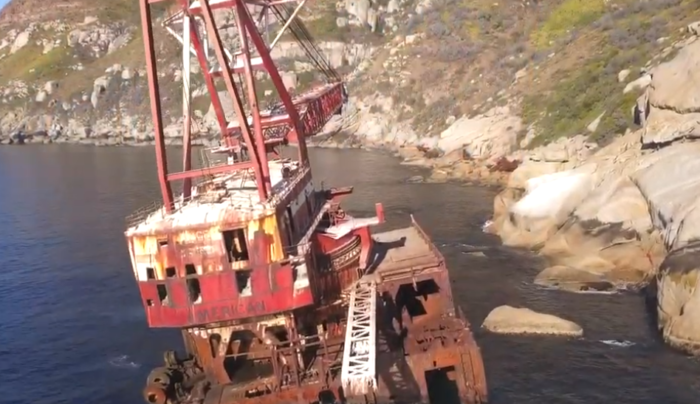Few can say they have had the unusual pleasure of journeying aboard the Cape’s and the country’s biggest shipwreck, but one local adventure seeker is among those who can.
Some 26 years ago a French crane barge by the name of BOS 400 ran ashore when a classic Cape storm stopped the massive vessel mid-journey. The BOS 400 was being towed by a smaller vessel when the storm hit and with the snap of a rope, destiny brought it to its final resting place on Duiker Island just 4.5km from Chapman’s Peak.
The giant vessel has stood the test of time along the coast line and is now a well-known landmark and even a hiking destination.
Daniel Johnson and a few friends took the opportunity to investigate the wreck as soon as they could.
“I had heard that it was possible to get to a large shipwreck in Cape Town, and when I later saw a YouTube video of it being explored, it seemed like it would be an unforgettable experience. I’ve always enjoyed hiking, and exploring unusual places, and I’ve been keen to get more experience with free diving, so this was the perfect chance to do each of those things, and see something unlike anything I’d seen before,” says Johnson.
To visit the famed, rusted monument hikers have to park at the Sandy Bay car park and make their way along the coastline without the help of any paths or signs.
After a short hike the massive wreck becomes visible in the distance and excitement guides you the rest of the way.
According to Johnson the unique condition of the wreck is certainly a sight to see.
“There were so many things which stood out about the experience, but what was perhaps the most notable was simply the sheer scale of it all. The whole experience was utterly surreal – exploring long-abandoned chambers, or swimming beneath the wreck, or looking down from the crane and seeing huge sections of the wreck which had broken off and sunk beneath the surface, all felt like something straight out of a movie. It was also fascinating to see how the wreck had been reclaimed by nature – there were cormorants nesting all along the walkway of the crane, seals and fish in the water around the wreck, kelp growing on the rusted metal beneath the surface, and a whole lot of crayfish on the levels which had been flooded,”
While this is Johnson’s first visit to a shipwreck in Cape Town, he says it has rare qualities that definitely make it stand out from the rest.
“This was actually the first wreck I’d been to in the Cape. It’s a rare example of a shipwreck which can be explored both above and beneath the surface, which made it perfect to see without scuba gear,” he adds.
Eager visitors are warned to be cautious when exploring as the once formidable structure has taken a beating over the years.
“The wreck has certainly deteriorated a lot over the last decade or so, it seems two major sections have broken off and fallen into the water. In many places, the floor is rusted away completely, and so one has to be very careful choosing a path through the wreck. Nonetheless, it remains very firmly in place, and is strong enough in most places to climb and explore. It seems most of the machinery which was used to operate the crane remains, and the crane itself is still held securely. Of all the shipwrecks I’ve visited or seen footage of around South Africa, this is without a doubt the most impressive, and the most intact,” says Johnson.
Take a peek aboard this magical time capsule on the Cape’s cost below:
Picture and video: Daniel Johnson






